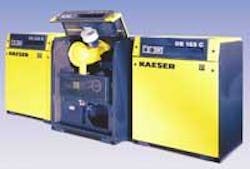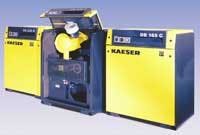New Blower Package Concept Streamlines Operation
Rotary-lobe, positive-displacement blowers are increasingly used in municipal water and wastewater treatment. Typical applications include agitating holding ponds to keep solids in suspension, backwashing grit filters, providing oxygen and agitation for aerobic digesters, gas collection and agitation of anaerobic digesters, differential pressure pumping, and conveying chemicals.
Rotary lobe blowers are preferred over other types of blowers and agitators because of their efficiency. For example, centrifugal type blowers control system capacity by restricting the inlet or discharge. While this technique effectively reduces the flow, it does not effectively reduce power consumption. With rotary-lobe blowers, varying the blower speed accurately controls flow and power requirements since they are directly proportional.
Electric motor-driven surface splashers are also being replaced by blower-based systems because the power consumption can be reduced by a factor of five. Plus, blower-based systems provide warm discharge air thus increasing process treatment effectiveness in cold conditions and reducing the cooling effect on treated water. These systems also eliminate the need to run three-phase power over water because positive-displacement blowers have enough pressure capacity to allow the blowers to remain on the shore with air piped to the diffusers.
Kaeser Compressors offers a factory designed and produced blower package that removes the engineering burden from the end-user. The company's new Com-paK Plus™ rotary-lobe blower package comes standard with many components that other suppliers offer as options. The heart of the package is the Omega Plus™ tri-lobe design blower. This type of blower is quieter than comparable two-lobe designs and offers reduced pulsations.
The Com-paK Plus™ package is complete with a sub-base, vibration isolators, inlet air filter, inlet silencer, discharge silencer, discharge check valve, relief valve, automatic V-belt tensioning, and oil drains piped to the front of the package with ball valves for draining the lubricant. The factory-engineered, powder-coated sound attenuating enclosure incorporates a ventilating fan. The standard motor is high-efficiency, totally enclosed, and fan-cooled.
The package blower system also has complete instrumentation mounted on the front panel — an inlet filter differential pressure gauge, a discharge pressure gauge, and a discharge temperature gauge. The discharge temperature gauge features an adjustable switch point and contacts for use in the plant control and monitoring system. All of the components are engineered to work together and mounted to provide an efficient, reliable, and quiet end product.
Because all components are already incorporated in the Com-paK Plus, installation costs are significantly reduced.
Most wastewater treatment installations have several blower units and each blower package must have clearance on all sides for maintenance and cooling (in addition to their base footprint). One of the benefits of Kaeser's new system is that the packages are designed for placement side-by-side and against the wall. The maintenance points are on the front of the package, while the utility and process connections are on the back. No special foundations or grouting is required.
In a plant expansion where more air is required to increase the plant capacity, a typical specification includes the construction of a new blower building to house the additional blowers. In many instances, it is less expensive to replace the existing packages with enough Com-paK Plus™ units in the existing location than it is to build an entirely new building with additional standard packages.
To help in the design process, Kaeser's 3-D modeling software produces a virtual walk-through of the proposed installation to review and, if necessary, modify variables such as distance, location, accessories and connections.

